Dublin printable map of top tourist attractions & city travel guide
Dublin city centre free travel guide - Top 10 Must-see sights & best destinations - Dublin top tourist attractions map
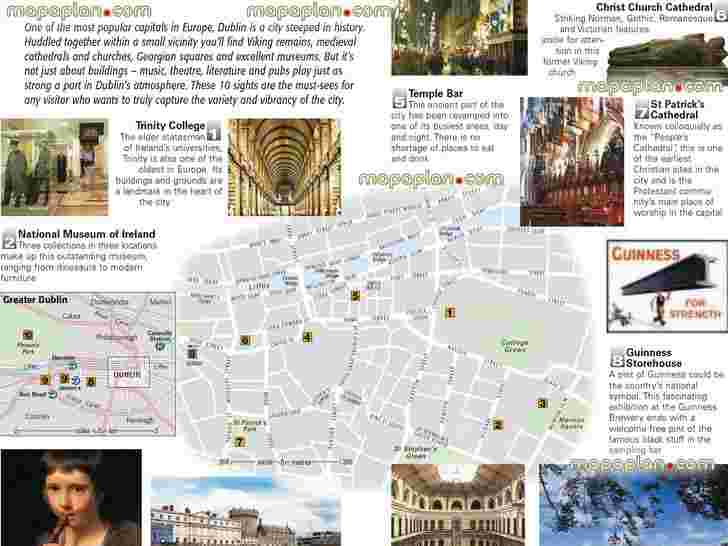
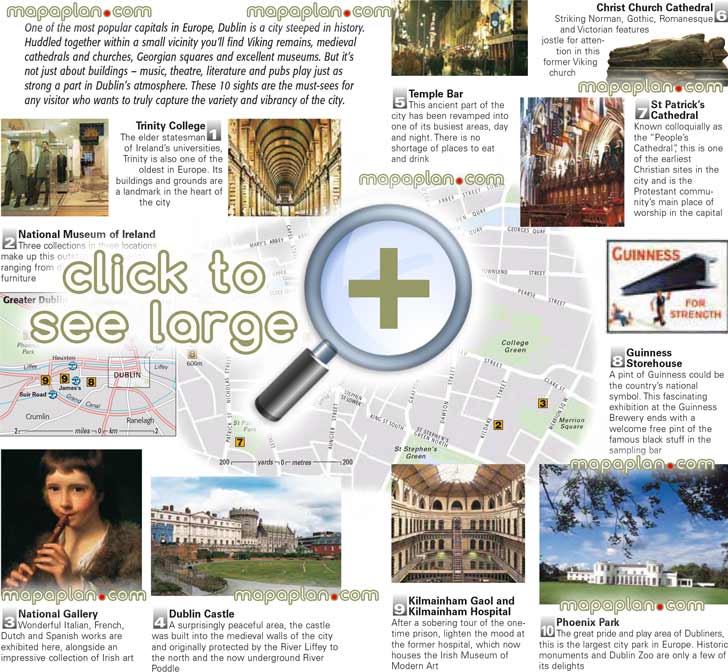
Maps of best attractions in Dublin, Ireland
Dublin maps will guide you to the best destinations in the city. Dublin is very easy for visitors to find their way around, largely due to an excellent tram (LUAS), rail (DART) and bus transportation systems. Dublin's top sights, plus hotels, shopping centres, and many of the city’s key landmarks are plotted on our detailed city plans. Public transportation points are also marked, and indicated by the symbols listed in the maps key. Armed with these maps, you should be able to find the accurate location of must-see places. Mapping out a trip to explore Dublin can be far from the usual. Unlike other European cities, this is one place where you cannot travel along the “dotted lines”, encouraging you to go beyond the norm. Dublin offers plenty discoveries with a complete mixture of the old and the new. It's a place where traces of diverse cultures can be found all over the city. If you have only one day in Dublin, geography is on your side. The vast majority of the capital’s best sites are concentrated in the city center, an area of no more than a few square kilometers. If you have a car, leave it behind. Walking is the quickest and most enlightening way to get around. That said, if you have limited mobility, the buses and taxis are a reasonably good alternative to cars. There's something different to experience every day in Dublin. This page includes a range of maps and plans which will help you make the most of your visit to Dublin. If you are either a first-time tourist looking for the top 10 must-do sights or if you are returning to Dublin to discover something new - all you need to ensure an enjoyable trip is some advance planning. For some help in narrowing down the options, we present you with a range of high resolution maps which will help you find the detailed locations of the must-see sights - just click on a selected map to access a large version that can be downloaded and printed, or saved onto your mobile device.
Dublin, Ireland visitor's map - Interactive plan showing inner city tourist attractions, main points of interest, museums, landmarks including Trinity College, Dublin Castle - Dublin top tourist attractions map
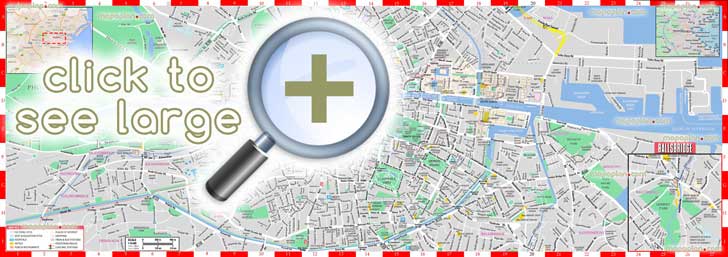
You can view, download or print a full, high resolution (detailed, large) version of this image by clicking on the plan itself
Map of DART & LUAS public transportation - Railway stations & light rail tram routes & stops - Overground metro subway diagram showing suburban train lines network, Airport Airlink & aerdart, feeder bus numbers - Dublin top tourist attractions map
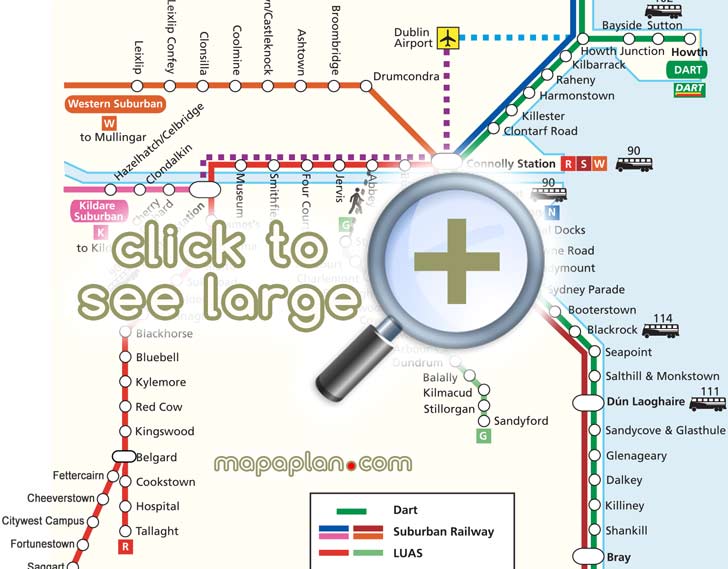
You can view, download or print a full, high resolution (detailed, large) version of this image by clicking on the plan itself
Printable walking map of favourite points of interest to visit by tourists - Old town & city centre great historic spots & best must-see sights - Dublin top tourist attractions map
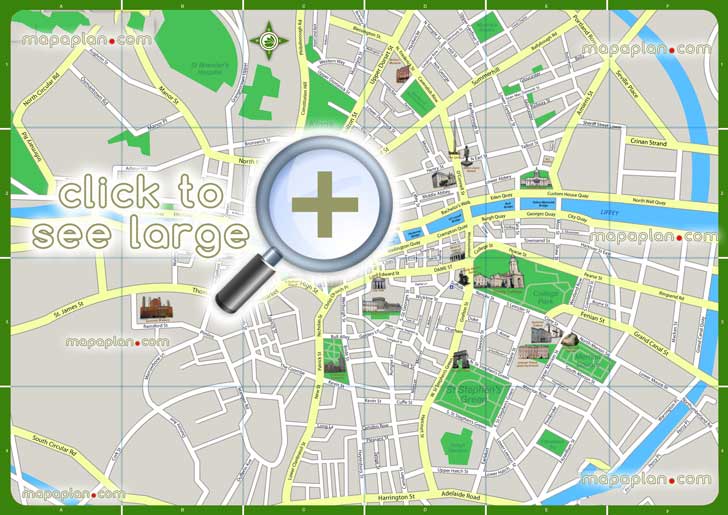
You can view, download or print a full, high resolution (detailed, large) version of this image by clicking on the plan itself
Free download the travel layout guide & offline map with the list of attractions & places to visit - Inner city plan showing places of interest along with street names & must-see destinations - Dublin top tourist attractions map
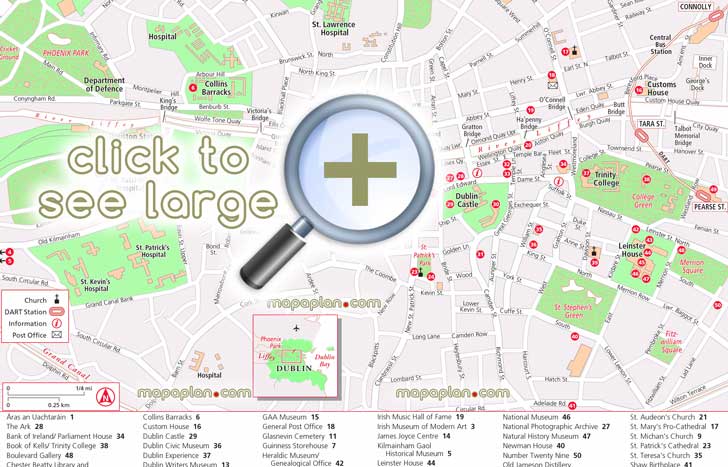
You can view, download or print a full, high resolution (detailed, large) version of this image by clicking on the plan itself
Dublin, Ireland city center points of interest - Public transport train transit stations & LUAS tram stops - Locations of the official tourist information centre - High quality road guide & street names large scale plan - Dublin top tourist attractions map
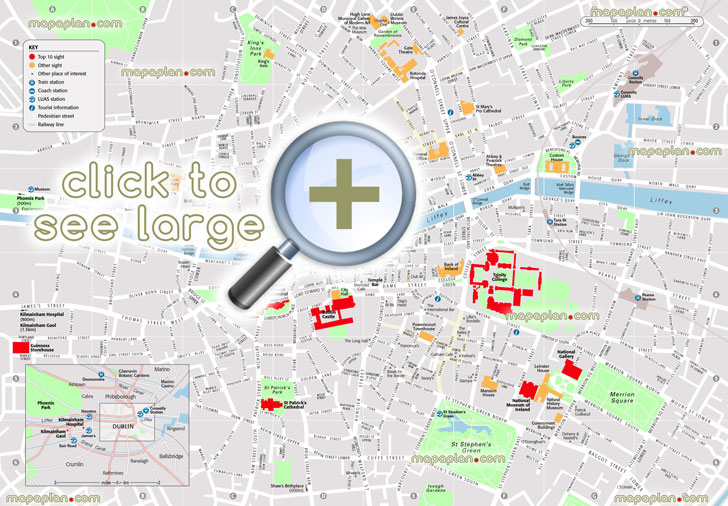
You can view, download or print a full, high resolution (detailed, large) version of this image by clicking on the plan itself
Top 10 attractions in the Greater Dublin metro area in Ireland - Virtual map showing best historical buildings - What to see, where to go, directions to fun things to do in the region - Dublin top tourist attractions map
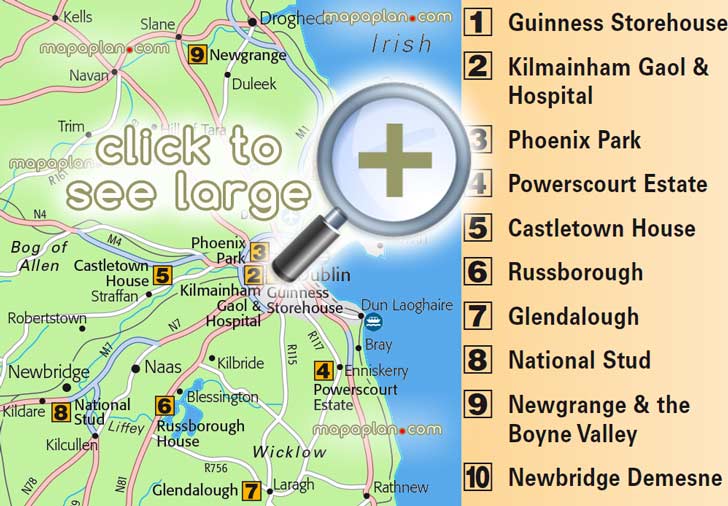
You can view, download or print a full, high resolution (detailed, large) version of this image by clicking on the plan itself
Simple & easy to navigate 3d aerial satellite view hd map of Dublin inner city centre showing holiday top points of interest, central walkable sites, city-break historical places to visit - Dublin top tourist attractions map

You can view, download or print a full, high resolution (detailed, large) version of this image by clicking on the plan itself
Hop-on hop-off bus map of Dublin City Sightseeing tour - Double decker open top red couch visitors' plan showing tour routes - Bird's eye graphical overview of the city trip highlights - Dublin top tourist attractions map
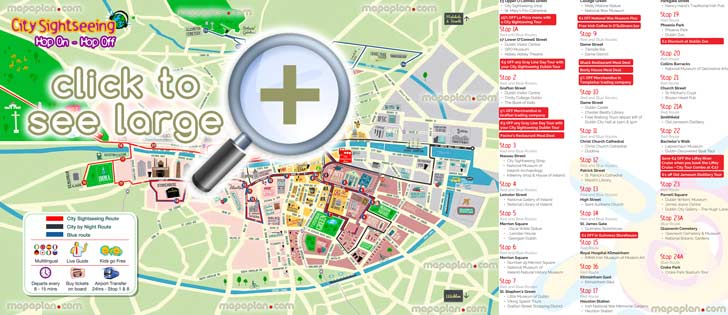
You can view, download or print a full, high resolution (detailed, large) version of this image by clicking on the plan itself
Hop-on hop-off bus map of Dublin Cityscape tour - Map showing travel sites & landmarks including Dublin Castle, Guinness Storehouse, Aviva Stadium - Dublin top tourist attractions map
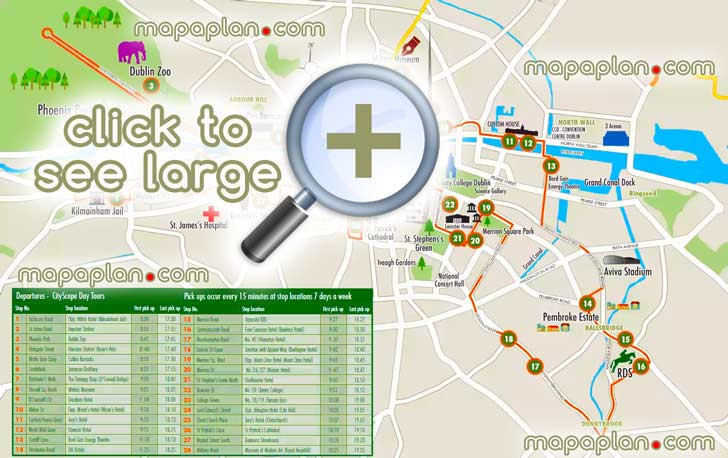
You can view, download or print a full, high resolution (detailed, large) version of this image by clicking on the plan itself
1-day trip itinerary planner - Best of Dublin travel map showing locations to visit, must-see tourist attractions, famous old town destinations, must-do spots & landmarks - Dublin top tourist attractions map
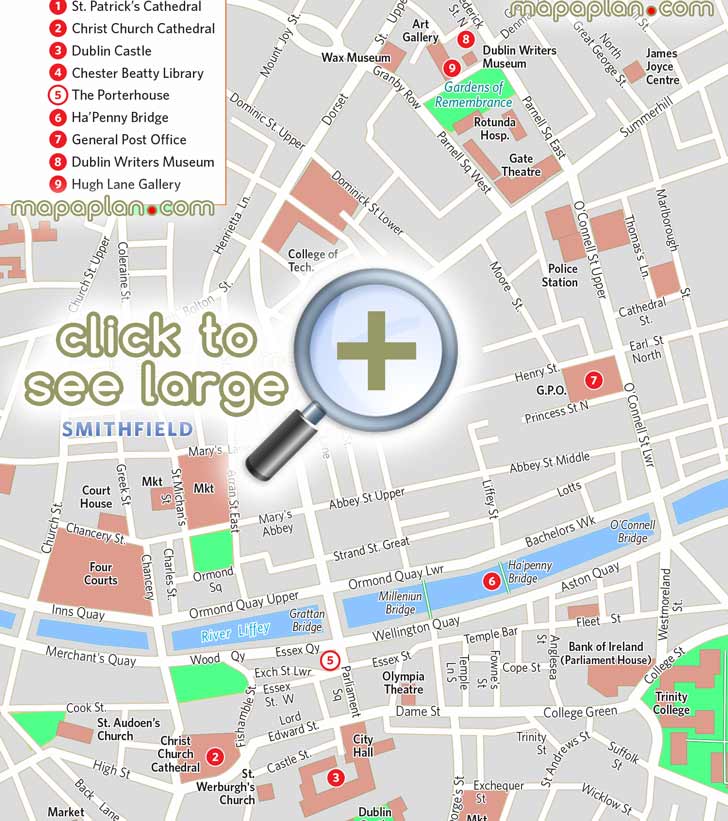
You can view, download or print a full, high resolution (detailed, large) version of this image by clicking on the plan itself
Temple bar interactive walking map to print before your trip - District area outline layout map of best locations to visit - Dublin top tourist attractions map
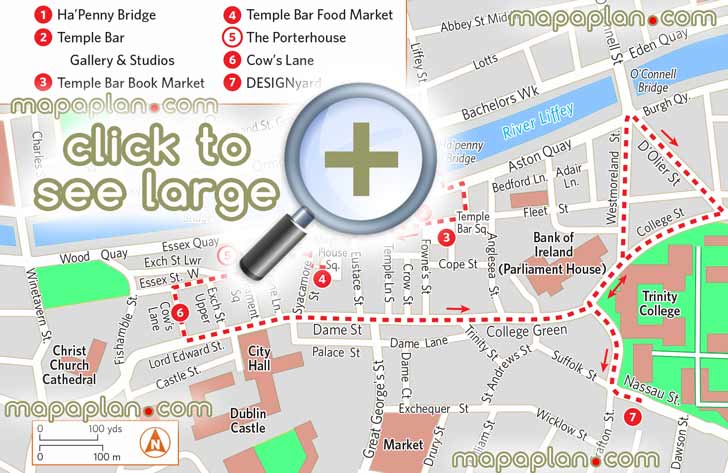
You can view, download or print a full, high resolution (detailed, large) version of this image by clicking on the plan itself
Pub crawl map showing the most iconic pubs and bars - Printable detailed travel visitors' orientation & navigation walking guide - Dublin top tourist attractions map
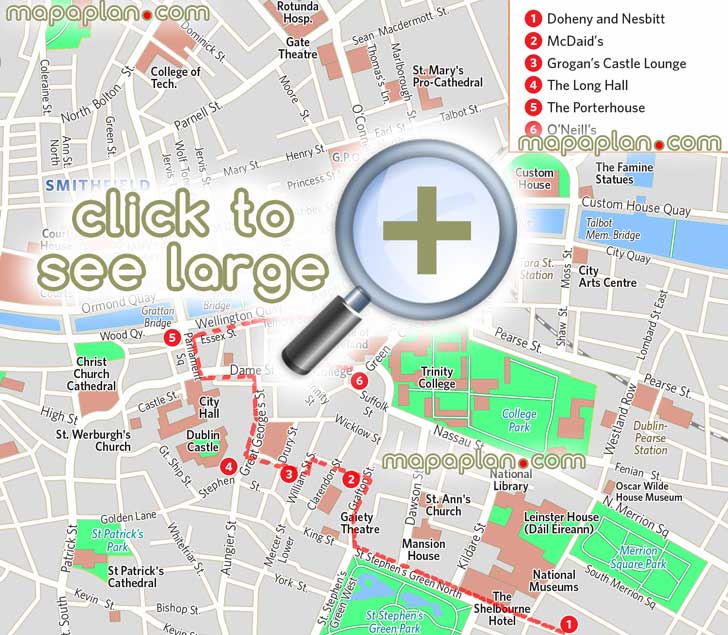
You can view, download or print a full, high resolution (detailed, large) version of this image by clicking on the plan itself
Downtown Dublin map of main hotels and city attractions - Best sights in a week detailed street plan & accommodation guide in English - Dublin top tourist attractions map
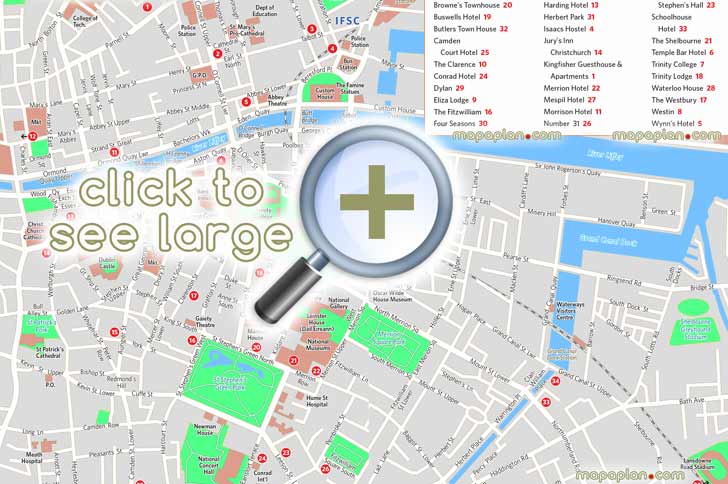
You can view, download or print a full, high resolution (detailed, large) version of this image by clicking on the plan itself
Best restaurants & cafes dining map of Dublin - Dublin top tourist attractions map
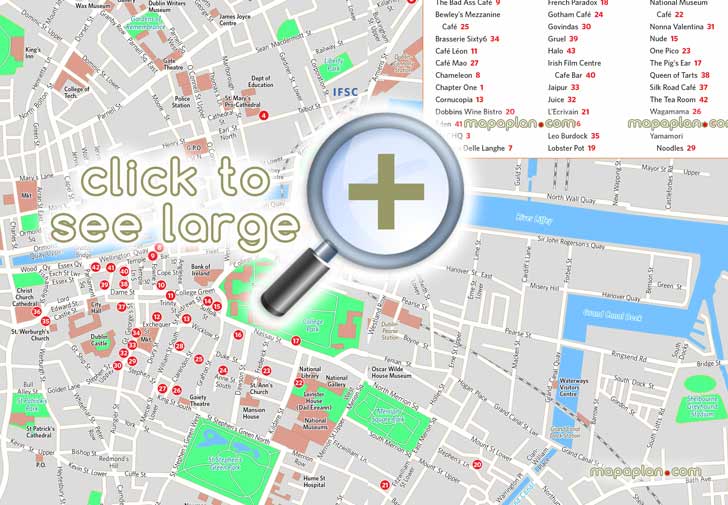
You can view, download or print a full, high resolution (detailed, large) version of this image by clicking on the plan itself
Shopping street map showing major department stores, list of most popular shops, favourite shopping destinations itinerary planner with navigation guide map - Dublin top tourist attractions map
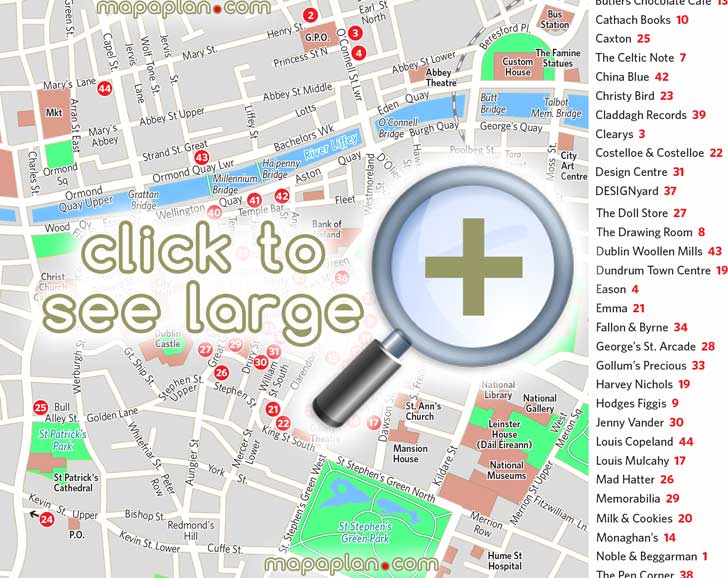
You can view, download or print a full, high resolution (detailed, large) version of this image by clicking on the plan itself
Central Dublin main tourist attractions - Key railway stations, River Liffey, places to visit, churches, theatres, museums, St Patrick's Cathedral - Dublin top tourist attractions map
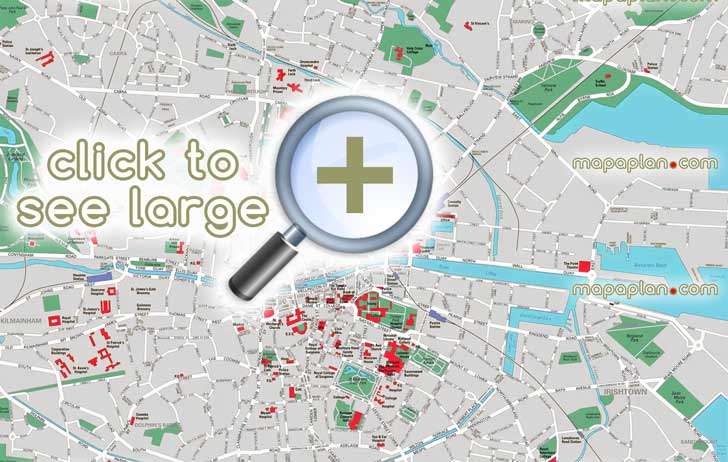
You can view, download or print a full, high resolution (detailed, large) version of this image by clicking on the plan itself
Colourful map for children - Great family things to do with kids - Fun & interesting ideas where to go around Dublin area - Free download DIY jigsaw puzzle plan of main villages and neighbourhoods - Dublin top tourist attractions map
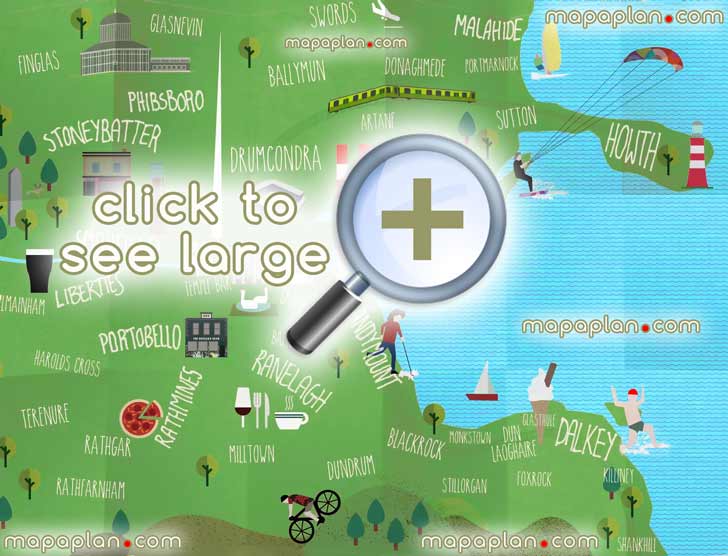
You can view, download or print a full, high resolution (detailed, large) version of this image by clicking on the plan itself
Map of top 10 attractions in Dublin
The typical top ten attractions are listed below. You can find the detailed locations of these places on the maps above.
- Trinity College - The elder statesman of Ireland's universities,Trinity is also one of the oldest in Europe. Its Buildings and grounds area landmark in the heart ofthe city.
- National Museum of Ireland - Three collections in three locations make up this outstanding museum,ranging from dinosaurs to modern furniture.
- National Gallery - Wonderful Italian, French,Dutch and Spanish works are exhibited here, alongside an impressive collection of Irish art.
- Dublin Castle - A surprisingly peaceful area, the castle was built into the medieval walls of the city and originally protected by the River Liffey to the north and the now underground River Poddle.
- Temple Bar - This ancient part of the city has been revamped into one of its busiest areas, dayand night. There is no shortage of places to eat and drink.
- Christ Church Cathedral - Striking Norman, Gothic, Romanesque And Victorian features jostle for attention in this former Vikingchurch.
- St Patrick's Cathedral - Known colloquially as the 'People's Cathedral', this is oneof the earliest Christian sites in the city and is the Protestant community'smain place of worship in the capital.
- Guinness Storehouse - A pint of Guinness could be the country's national symbol. This fascinating exhibition at the Guinness Brewery ends with a welcome free pint of the famous black stuff in the sampling bar.
- Kilmainham Gaol and Kilmainham Hospital - After a sobering tour of the onetime prison, lighten the mood at the former hospital, which now houses the Irish Museum of Modern Art.
- Phoenix Park - The great pride and play area of Dubliners,this is the largest city park in Europe. Historic Monuments and Dublin Zoo are only a few of its delights.
What are some interesting facts about Dublin?
Location - Discover for yourself the wonders of this city with an exceptional past. Dublin, Ireland's capital, is located on the East Coast, stretching along the Irish Sea in a half moon shape. It lies at the mouth ofthe River Liffey in a land area of approximately 115 square kilometers. Dublin is bordered to the South by the dramatic Wicklow Mountains and is surrounded by flat farmlands to the north and west.The Liffey River cuts the city into two, namely the Northside and the South Side.
DART - Dublin Area Rapid Transit is Dublin's suburban railway and runs parallel with the coast from north to south. Services are frequent. At peak hours trains arrive every 5 minutes or so, but off-peak frequency can drop to one every 25 minutes. The most central stations are Pearse Street, Connolly Station, and Tara Street.
LUAS - It is a brand new light rail system running across the city and connecting many of the top attractions as well as the major shopping districts. The red line runs from Connolly train station to Tallaght in the southwest, and the green line runs from St. Stephen's Green to Sandyford in the south suburbs. You need to buy tickets before boarding and ticket machines are located at every stop.
Buses & Bicycles - There are also a number of bus tours offering a 'hop-on, hop off' tours like Dublin Bus Tours, but the best way to explore Dublin is to hire a bicycle. For the most part, Dublin is fairly flat with a few, modest climbs and you can park your bike anywhere, though you will find dedicated parking spots in many city center locations.
Airport - Dublin Airport is 11.25km (7 miles) north of the city. The most affordable way to get from the airport into the city is by public bus.
History - Most of the structures of the bygone eras have either been refurbished or restored, the original can no longer be seen. However there are still several cultural mementos and historical artifacts scattered throughout the city. Aboriginal stone wall built during the Medieval years can still be found along Lamb Alley, right in the heart of the city. This part of the wall that surrounded the city during the 11th century, used to have gates to allow passage to and from the castle. One of the original gates still exists along Cook's Street. In Christ Church Cathedral, which is one of the most famous buildings in modern Dublin, many relics and artifacts, as well as beautiful objects that the church owned, can be seen.
Navigate Dublin using the street numbers - Dublin is a city divided into two, cut into half by the Liffey River. The Northside and the South Side.Getting around is easy enough considering its size. To locate an address, postal codes will help you find what you are looking for. Odd numbers are on the Northside and even numbers are on the South side, and one hint for travelers is, the higher the number, the further away the location will be from the city center.
Living between two canals - Compared to other European capitals, Dublin is a relatively small metropolis and easily traversed. The city center—identified in Irish on bus destination signs as AN LAR—is bisected by the River Liffey flowing west to east into Dublin Bay.Canals ring the city center: The Royal Canal forms a skirt through the northhalf, and the Grand Canal the south half. True Dubliners, it is said, live between the two canals.
River Liffey - The focal point of Dublin is the River Liffey, with 16 bridges connecting its north and south banks. The Most famous of these, O'Connell Bridge, was originally made of rope and could only carry one man and a donkey at a time. It was replaced with a wooden structure in 1801.
How can I find specific tourist attractions on the map of Dublin?
Our interactive city maps are easy to explore. You can pan, zoom in, and zoom out on the high-resolution map to locate major tourist attractions. Each map highlights key landmarks, making it simple to find the sights you're most interested in, whether it's a famous monument, museum, or other point of interest.
Can I get a visual representation of the area around Dublin?
For some cities, we provide a general view of the area surrounding popular attractions. While this image won't show the exact street-level view, it helps you understand the layout of the neighborhood, showing how the landmarks are situated in relation to other points of interest around Dublin.
Can I explore maps for both tourist attractions and other points of interest?
Yes! Our platform offers maps covering a range of highlights, from top tourist attractions to other noteworthy areas such as parks, restaurants, and entertainment venues. Whether you're planning a visit to a museum or looking for a nearby park, our detailed maps make it easy to find the best spots in the city.
Related keywords
2023, 2024, 2025, 2025, 2026, 2027, 2028, 2029, map, plan, download, print, printable, free, detailed, aerial, bird's eye, satellite, guide, planner, travel, sightseeing, visit, trip, tour, tourist, what to do, where to go, things to do, must see, top attractions, points of interest, places, sites, sights, buildings, spots, destinations, locations, landmark, museum, in a week, in 3 days, one day, city, route, bus, kids, children, top 10, top ten, popular, famous, interesting, highlights, public transport, rail, hotels, updated, metro, subway, underground, tube, downtown, coach, nightlife, pub, monument, satellite, accommodation, transit, transportation, supermarket, children, metro, subway, underground, tube